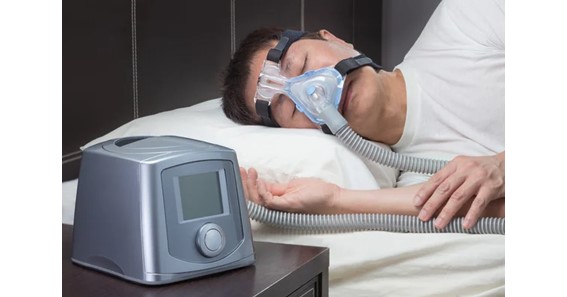Sleep apnea is a serious disorder that can have serious repercussions on an individual’s physical and mental health. A machine for sleep apnea can help to alleviate its symptoms and provide relief from the disorder. This machine works by delivering continuous positive airway pressure (CPAP) to the patient during sleep, which helps to reduce the number of pauses in breathing that occur during sleep apnea episodes. It also helps reduce snoring and other associated symptoms, providing relief from this potentially life-threatening condition. In this article, we will discuss how a machine for sleep apnea works, its benefits, and how it can improve quality of life for those suffering from this condition.
What is Sleep Apnea?
Sleep apnea is a serious and potentially life-threatening sleep disorder that occurs when a person’s breathing is repeatedly interrupted during sleep. Sleep apnea can lead to serious health problems, such as high blood pressure, heart disease, stroke, and diabetes. It’s estimated that over 18 million Americans have the condition and it affects both men and women of all ages.
There are two main types of sleep apnea: obstructive sleep apnea (OSA) and central sleep apnea (CSA). OSA is the most common type of the disorder – it occurs when the upper airway becomes blocked during sleep due to soft tissue collapsing inwards. This prevents air from entering or exiting your lungs properly, resulting in loud snoring, pauses in breathing (apneas), or shallow breaths known as hypopneas. Fortunately, the use of a sleep apnea machine can help to reduce or even eliminate these pauses in breathing.
CSA is much less common than OSA and occurs when the brain fails to send signals to the muscles responsible for controlling breathing during sleep. As a result, those affected by CSA may experience long pauses between breaths or very shallow breaths throughout their sleeping period.
The signs and symptoms of both types of sleep apnea are similar but can vary between individuals – these include excessive daytime fatigue.
Click here – Protect Your Device with Leather Phone Cases
Causes of Sleep Apnea
Sleep apnea is a sleep disorder that affects millions of people around the world. It is characterized by pauses in breathing during sleep and can have serious health consequences if left untreated. While there are several different types of sleep apnea, the most common form is obstructive sleep apnea (OSA). This article will explore some of the causes of OSA and how it can be treated.
The primary cause of OSA is an obstruction in the airway, usually due to excess weight or enlarged tonsils or adenoids. Excess fat tissue around your neck or throat can also contribute to this obstruction, making it harder for you to breathe while you’re asleep. In addition, people with narrow airways may be more likely to experience OSA due to an increased chance of their airway collapsing during sleep. Smoking and drinking alcohol are also known risk factors for developing OSA as they both have a relaxant effect on your throat muscles, making it easier for them to collapse while you’re sleeping.
Certain medical conditions such as asthma and chronic sinusitis can also increase your risk for developing OSA as they can cause inflammation in your airways which makes them narrower and more prone to collapse when you’re asleep.
Symptoms of Sleep Apnea
Sleep apnea is a serious sleep disorder that affects millions of people worldwide. It occurs when a person’s breathing temporarily stops and starts during sleep, often for several seconds at a time. It can cause loud snoring, daytime fatigue, and other health problems. Recognizing the signs and symptoms of sleep apnea is the first step in seeking treatment to improve your quality of life.
The most common symptom of sleep apnea is loud snoring, which may be accompanied by pauses in breathing or gasping for air during the night. This disruption to your sleeping pattern can make it difficult to stay asleep throughout the night or wake up feeling rested in the morning. You may also experience excessive daytime fatigue or difficulty concentrating due to lack of restful sleep caused by obstructive sleep apnea (OSA). Other common symptoms include:
– Morning headaches
– Dry mouth or sore throat upon waking up
– Difficulty staying asleep throughout the night
– Waking up with a choking sensation
– Feeling restless during the night
It’s important to seek medical attention if you suspect you have OSA as it can cause long term health issues such as high blood pressure, increased risk for stroke and heart attack and memory loss.
Click here – Reduce Room Reverb with Homemade Acoustic Panels
Diagnosis and Treatment
Diagnosis and treatment are two of the most important aspects of healthcare. The diagnosis is the process of determining the cause and nature of a medical condition, while treatment is the administration of medication or other interventions to help alleviate symptoms or prevent further complications. Diagnostic tests such as laboratory tests, imaging, and physical examinations can provide valuable information about an individual’s health status. Treatment plans for various conditions can vary depending on the type and severity of the condition, as well as any underlying medical conditions that may be present.
The first step in diagnosing any medical condition is obtaining a thorough history from the patient. This includes questions regarding signs and symptoms, past medical history, family history, lifestyle factors such as diet and exercise habits, environmental exposures, medications taken regularly or recently stopped taking; this information helps to inform what diagnostic tests should be done next. Once all necessary diagnostic tests are completed (such as blood work or imaging studies), results are typically reviewed by a physician to determine what further steps should be taken in order to properly diagnose the condition.
Treatment plans for various conditions depend on many factors including diagnosis (i.e., type/severity), underlying health issues (if any), age/lifestyle factors (diet/exercise habits).
Benefits of Using a Machine for Sleep Apnea
Sleep apnea is a condition that affects millions of people around the world. It can cause disruption to sleep and have serious health consequences if left untreated. One of the most effective treatments for sleep apnea is the use of a continuous positive airway pressure (CPAP) machine. This article will discuss some of the benefits of using a CPAP machine for sleep apnea treatment.
A CPAP machine works by delivering pressurized air through a mask that fits over your nose and mouth while you are sleeping. The air pressure helps keep your airway open, so it can prevent snoring and other signs associated with obstructive sleep apnea (OSA). By keeping your breathing regular, it also helps reduce episodes of oxygen deprivation that can occur when OSA goes untreated. Using a CPAP machine has been shown to improve quality of life, reduce daytime fatigue, improve alertness during waking hours, as well as reduce episodes of oxygen deprivation during sleep.
CPAP machines are also beneficial in terms of cost savings when compared to other treatments for OSA such as surgery or dental appliances. Additionally, they are relatively easy to use and maintain at home without needing any medical professional assistance after initial setup by an experienced doctor or technician.
Types of Machines Used for Sleep Apnea
Sleep apnea is a medical condition characterized by pauses in breathing during sleep. It can be caused by several different factors, including obesity, smoking, and aging. To diagnose and treat it effectively, machines are used to monitor the body’s respiration and oxygen levels during sleep. Let’s look at the types of machines used for sleep apnea.
CPAP (Continuous Positive Airway Pressure) machine: This type of machine is the most commonly prescribed for people with moderate to severe cases of sleep apnea. It works by providing a continuous flow of air through a mask worn over the nose or face while sleeping. The pressurized air helps keep your airways open throughout the night so that you can breathe better while sleeping.
BiPAP (Bilevel Positive Airway Pressure) Machine: This machine works similarly to CPAP but also provides two levels of pressure — one lower pressure when you inhale and a higher pressure when you exhale — which helps make breathing easier throughout the night. It is usually recommended for people with more severe cases of sleep apnea who have difficulty using CPAP machines or have other health complications such as COPD or heart failure that require extra support while they’re asleep.
Conclusion
Machines for sleep apnea are a great way to help people suffering from the condition get better quality sleep. These machines can provide relief from symptoms like snoring and daytime fatigue, as well as reduce the risk of serious health complications associated with untreated sleep apnea. It is important to discuss your options with your doctor so that you can find the best machine for your individual needs.






